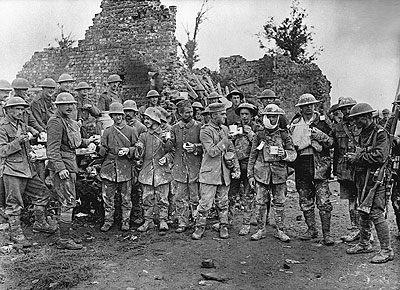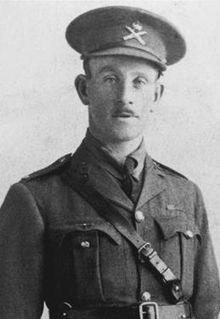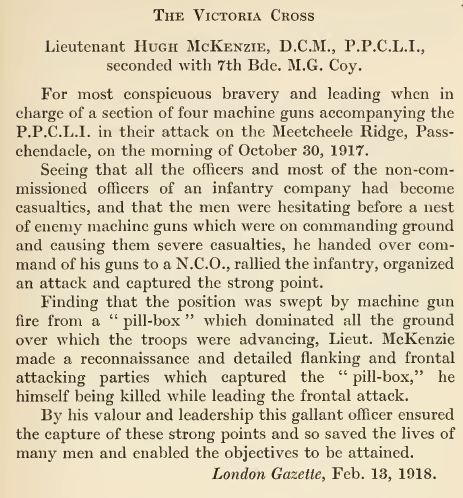
The Victoria Cross (VC) is the highest military honour of the British Empire and the Commonwealth of Nations, being awarded only for extraordinary valour and devotion to duty while facing a hostile force. It is the highest honour in the Canadian honour system, placed before all other orders, decorations and medals, including the Order of Canada, in the Order of Precedence. It was historically awarded to members of the Canadian Forces of any rank in any service, and to allies serving under or with Canadian military command.
The Victoria Cross has been presented to 96 Canadians, or people closely associated with Canada, between its creation for acts performed during the Crimean War and 1993 when the Canadian Victoria Cross was instituted. No Canadian has received either honour since 1945.
 Hugh McDonald McKenzie VC DCM (5 December 1885 – 30 October 1917) was a Canadian soldier who served during World War I. McKenzie received the award posthumously for his actions during an attack that took place during the Battle of Passchendaele in October 1917. McKenzie was born in Liverpool, in the United Kingdom, on 5 December 1885. Shortly after his birth the family moved to Inverness, in Scotland. After his father died, the family moved to Dundee and McKenzie later found work with the Caledonian Railway Company. He emigrated to Canada in 1911, living with his wife, Marjorie, in North Bay, Ontario. In August 1914, shortly after the outbreak of the First World War, McKenzie volunteered for the Canadian Expeditionary Force and enlisted in the Princess Patricia’s Canadian Light Infantry.[2] On enlistment, his attestation papers state that he had been previously employed as a teamster and that he had had previous military experience. Serving initially as a private, McKenzie was promoted steadily through the ranks, reaching sergeant in September 1916 and becoming a company sergeant-major in early 1917. As a corporal, in early 1916, he had received the Distinguished Conduct Medal for actions while in command of a machine-gun section. In January 1917, he was commissioned as a second lieutenant and was transferred to the Canadian Machine Gun Corps, attached to the 7th Brigade Machine Gun Company.
Hugh McDonald McKenzie VC DCM (5 December 1885 – 30 October 1917) was a Canadian soldier who served during World War I. McKenzie received the award posthumously for his actions during an attack that took place during the Battle of Passchendaele in October 1917. McKenzie was born in Liverpool, in the United Kingdom, on 5 December 1885. Shortly after his birth the family moved to Inverness, in Scotland. After his father died, the family moved to Dundee and McKenzie later found work with the Caledonian Railway Company. He emigrated to Canada in 1911, living with his wife, Marjorie, in North Bay, Ontario. In August 1914, shortly after the outbreak of the First World War, McKenzie volunteered for the Canadian Expeditionary Force and enlisted in the Princess Patricia’s Canadian Light Infantry.[2] On enlistment, his attestation papers state that he had been previously employed as a teamster and that he had had previous military experience. Serving initially as a private, McKenzie was promoted steadily through the ranks, reaching sergeant in September 1916 and becoming a company sergeant-major in early 1917. As a corporal, in early 1916, he had received the Distinguished Conduct Medal for actions while in command of a machine-gun section. In January 1917, he was commissioned as a second lieutenant and was transferred to the Canadian Machine Gun Corps, attached to the 7th Brigade Machine Gun Company.
He was 31 years old, and a lieutenant when the following deed took place for which he was awarded the VC:
From “Legion Magazine” “By Oct. 30, the fifth day of the offensive, the Canadians were in a position to assault what was left of Passchendaele village. The 49th Bn. and the Princess Patricia’s Canadian Light Infantry, (PPCLI), were in the vanguard of the attack from Meetcheele Spur. Lieut. Hugh McKenzie, who was in charge of four guns of the 7th Canadian Machine Gun Corps, saw all the officers and non-commissioned officers of the PPCLI mowed down by machine-gun fire. The survivors of the unit could not advance, but they staunchly refused to retire and so stood their ground waiting for someone to take charge. McKenzie placed a corporal in charge of his guns and strode out onto the battleground to investigate.
It quickly became obvious that a German pillbox atop a hill had inflicted the damage that was holding up the advance. Taking charge, McKenzie organized a few parties of the PPCLI to circle the flanks of the concrete stronghold and then attack it from the rear where the entrance was located. Leading one of the parties was Sergeant George Mullin.
To draw fire away from the raiding parties, McKenzie led his group on a frontal attack directly up the slope leading to the pillbox. As they charged ahead they were met with deadly fire from the fort.
Mullin rushed the stronghold head-on, blasting it with hand grenades. He then climbed on top of the emplacement and shot both machine-gunners dead. Ironically, McKenzie, charging up the hill, was killed by a bullet through the head. Mullin forced his way into the pillbox through the entrance and took the surviving occupants prisoner. Both McKenzie and Mullin were awarded VCs, the former posthumously.”

